Charleston Harbor is home to one of the most significant historic sites in the nation; Fort Sumter. This massive brick structure at the entrance to the harbor saw the first shell of the Civil War explode above its walls. With that said, there are other historic military compounds around the perimeter of the harbor…each having significance in their own unique way. Come on along as we tour these fascinating locations and find out the importance each one holds. We even found a few surprises along our path!
Fort Sumter

Fort Sumter was not the first defense built in Charleston Harbor, but it was by far the most imposing. Built in 1829, it was intended to defend against invaders coming in from the ocean. Able to fire cannons at three levels, it appeared to be invincible. The Confederate states needed control of this fort, in order to bring supplies into Charleston and beyond. On April 12, 1861, Confederate Brigadier General P.G.T. Beauregard ordered his soldiers to fire upon the garrison that was held by Union Major Robert Anderson and 85 men under his command. It was a difficult decision for Beauregard, as Anderson had been his artillery instructor at West Point. The Union soldiers were not effective in hitting any Confederate targets, as the rebel forces were spread out around the large waterway. The flip side of the coin was that Beauregard’s men had one thing to focus on, and they inflicted heavy damage. When the Union soldiers called a truce on April 14, Fort Sumter had been heavily damaged. Amazingly, no one had been killed in the battle on either side.
Once the Confederates held the structure, it was the Union’s turn to try to get it back. Several attempts were made, but the South had a firm hold on it and the harbor. Remember the building was tall, massive, and made of brick. By 1865, the North had pounded it with seven million pounds of artillery shells. Most of that brick fell and created a solid mound of material that was stronger than the original fort. Only Sherman’s troops approaching on their March to the Sea, were enough to cause the Confederate troops to abandon the fort.
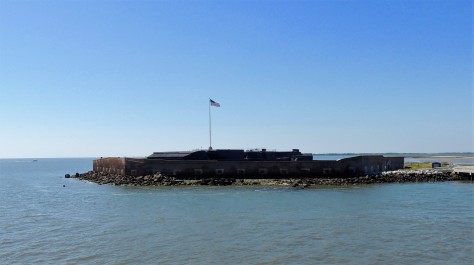
Today’s structure bears little resemblance to the original. The fallen brick has been cleared away and the lower portion of the walls are once again in view. The black concrete battery in the center of the fort was completed in 1899, in preparation for the impending Spanish-American War.
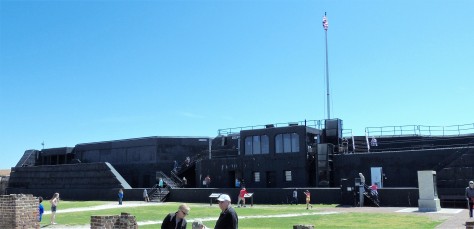
That battery was manned in both World Wars I & II, after which point the fort was decommissioned.
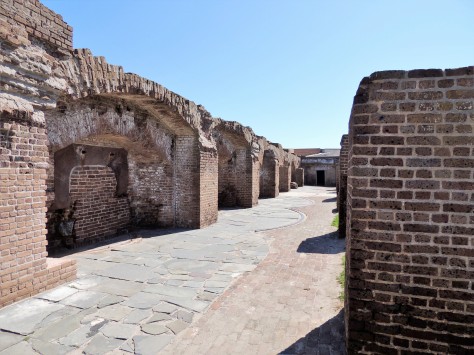
Little remains of the lower level casemates.
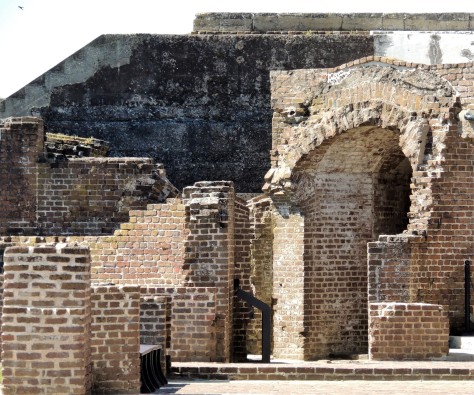
The older brick against the relatively newer concrete.

This massive leaning wall was knocked off kilter when the powder magazine behind it accidentally exploded, killing 11 Confederate soldiers. The National Park Service has installed these metal supports to prevent it from moving further.
Note that access to the island is by ferry boat, either from Liberty Square in Charleston or from Patriot’s Point in Mt. Pleasant.
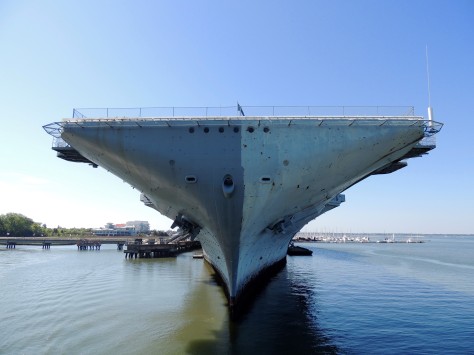
We chose the latter, which gave us this awesome bow view of the U.S.S. Yorktown aircraft carrier as we passed by!
Castle Pinkney
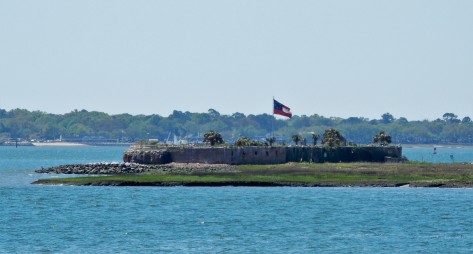
Castle Pinkney sits in the center of the harbor, between Fort Sumter and Charleston. Built in 1810, it was used for six weeks as a prisoner of war camp during the Civil War. It also housed artillery, although it is believed that a hostile shot has never been fired from there. In 1924 it was designated as a national monument, only to see that status taken away in 1951. It was deemed excess property and sold to the South Carolina in 1958. Attempts to turn it into a tourist attraction failed, so the state tried to give it back to the federal government. They declined the offer. The Sons of Confederate Veterans took over care of the island, but were unable to raise the cash to buy it. Finally, in 2011, the State of South Carolina sold Castle Pinckney to the Sons of Confederate Veterans for the sum of $10…in Confederate currency. The Stars and Bars of the Confederacy fly over it today.
Fort Johnson
Fort Johnson was built in 1708. Only a small powder magazine remains at the site that actually fired the first shot of the Civil War. The rest of the site is occupied by South Carolina Fish and Wildlife and the College of Charleston. It is unfortunate that this prominent place in American history wasn’t preserved.
Fort Moultrie
Last, but by no means least, is Fort Moultrie. This location has the longest history of all the Charleston garrisons, having been manned for 171 years.
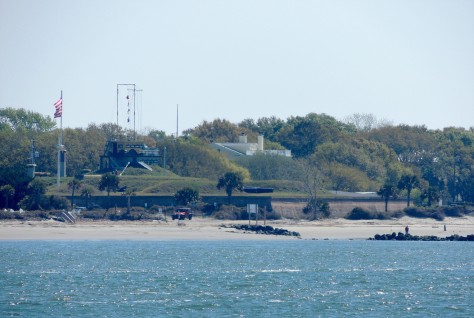
Located on Sullivan’s Island, this was the second defensive structure built to protect Charleston. Due to the natural curve in the river channel, ships had to pass here before they were ever within sight of town. Soldiers would fire a cannon to notify the townsfolk of an approaching ship. In 1776, a palmetto log fort was constructed by Colonel William Moultrie and his men to defend against a British invasion. They fought a one day battle that heavily damaged the enemy ships, yet little damage was done to the fort. Turns out that palmetto logs, a member of the cabbage family, are fibrous. The British cannonballs simply bounced off. To add insult to injury, the American soldiers would retrieve the balls and fire them back.
During the battle, the soldiers wore hats with a crescent. The shape had the word ‘Liberty’ inscribed in it. This was also on South Carolina’s flag. A palmetto tree was added to the flag at a later date to signify the palmetto logs of Fort Moultrie.

That symbol is everywhere throughout the state. Coffee mugs, keychains, license plates…you name it. At first glance, we thought the flag represented a waning moon rising or setting over a palm tree. The crescent represents a gorget, the throat plate that protected officers’ throats at that time. In designing the flag, Colonel Moultrie chose the the crescent and blue color to match the uniforms they wore. So much for that romantic image of an evening walk on a South Carolina beach with your sweetheart. 🙂
Between the Revolutionary and Civil wars, the fort continued to be manned. It is interesting to note that a young private by the assumed name of Edgar A. Perry was stationed there from 1827 through 1828. We know him as Edgar Allan Poe. Fittingly, the establishment we ate at on the day of our tour of the fort was called Poe’s Tavern.
Another resident of the fort at that time was the famous Seminole leader, Osceola. He was held there by the U.S. Army after being taken prisoner under a flag of truce in Florida. In failing health, Osceola died there in 1838.
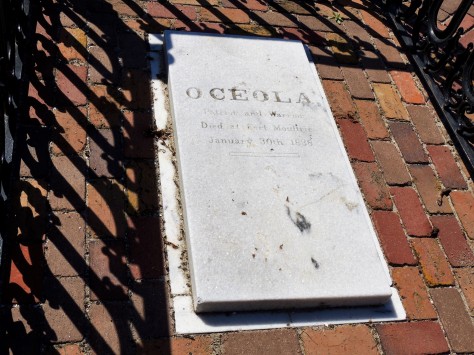
His grave lies just outside the fort gate. The John Anderson classic Seminole Wind came to mind as we stood there. While it is sad that he isn’t buried in Florida, it is nice that he is given an honorable grave. Also on the property is Colonel Moultrie’s grave, which is along the shore of the cove behind the visitor center.
At the beginning of the Civil War, Major Robert Anderson was originally garrisoned at Fort Moultrie. By 1861, the walls had gone from palmetto to being made of brick. However, the Union commander felt it was indefensible, as the area around it had been developed with homes that looked down into it. The Confederate army took over the post after Anderson and his men left for Fort Sumter. Fort Moultrie had one of the best positions to shell Fort Sumter, with only a mile separating them.
Like Fort Sumter, Fort Moultrie had batteries built in the late 1800’s.
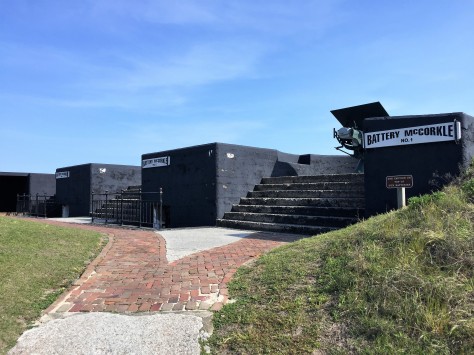
These were used through World War II. A gas and bombproof building was added following World War I.

Referred to as HECP/HDCP, it was a joint command post run by the Army and Navy. The building is maintained as a museum as it would have looked in the 1940’s. It is interesting to note that German U-boats slipped past this post and mined Charleston’s harbor at different times in the war.

We had a great time exploring the forts around Charleston this week. We even earned two Junior Ranger badges in the process! Stay tuned for one last adventure in Charleston, along with our move up the coast. We hope you will tag along!

Excellent History lesson Jim! Enjoyed all the facts and knowledge you gleaned from this adventure. My Jim will love the details as he is a true War History lover!
LikeLiked by 1 person
Thanks, Brenda! What an amazing town. Glad we were able to discover part of it with you two!
LikeLike
So much history in one Southern City. Sounds like you are having a fantastic time.
LikeLiked by 1 person
We sure did, Bonnie!
LikeLike
Very interesting about the flag. Did not know that but a cool history lesson. ☺ Thanks for sharing, you guys have fun and take care, Rick
LikeLiked by 1 person
Thanks, Rick! Another interesting point about the flag: there isn’t a standard symbol. Depending on the manufacturer, some of the palmetto trees are more elaborate than others.
LikeLike
Wow! Sounds like you guys really enjoyed Charleston. We’re looking forward to visiting there soon. Thanks for the history lesson and awesome information.
LikeLiked by 1 person
We sure did, David and Sharon! It’s definitely a place we could spend more time in.
LikeLike
Interesting information on the forts and their history. They certainly played a big role back in their day. Thanks for sharing.
LikeLiked by 1 person
I found the Osceola grave interesting, as there is an Osceola county in Michigan…even though he was never there. The Seminole tribe has quite a history, Jim.
LikeLike
Very informative. I always thought the flag was a moon over the palm tree! Not sure if you watch the Big Bang Theory, but that would make a good “fun with flags episode!”
LikeLiked by 1 person
That’s too funny, Jonell! I could see Sheldon discussing that. 🙂
LikeLiked by 1 person
Always enjoy your blogs with the history lessons!
LikeLiked by 1 person
Thanks, Steve and Dianne!
LikeLike